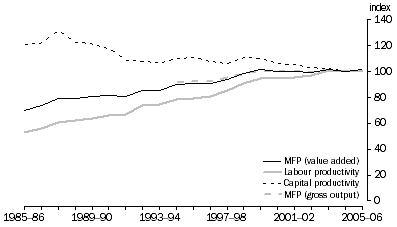PRODUCTIVITY
Between 1985-86 and 2005-06 average annual MFP growth on a value added basis was around 1.8% per year, which is stronger than average annual market sector MFP growth over this period (1.2% per year). While there was a relatively strong increase in MFP up to 1999-00, it has levelled out since then. Labour productivity has also trended upwards (figure 13.1) since 1985-86, although the pace has slowed since 1999-00. Capital productivity has followed a downward trend since 1988-89.
13.1 Finance & insurance MFP, labour productivity and capital productivity, (2004-05 = 100)

Underlying the changes in the productivity estimates are the changes in output and the factors of production. Figure 13.2 presents the series for these indicators. The labour index has increased slowly since the early 1990s following a fall from the peak in 1989-90
footnote 1. The output and capital input series both increased at roughly the same rate through the course of the last 20 years.
There is little difference between the gross output and gross valued added measures of MFP. Growth in intermediate inputs through the latter part of the 1990s slowed growth in gross output based MFP relative to the gross value added measure. The fact that there is only a small difference in growth is unsurprising given the relatively low use of intermediate inputs by this industry, at 35% of total input cost in 2004-05.
1 The higher labour index in recent years reflects a combination of an increase in average hours worked and employment, though employment is still just below the peak recorded in 1989–90. back
 Print Page
Print Page
 Print All
Print All